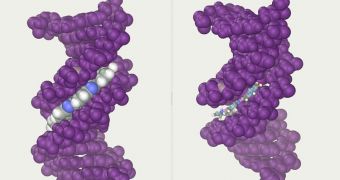US National Institute of Standards and Technology (NIST) investigators announce the development of a Slinky capable of measuring and manipulating DNA molecules. Their instrument is about 10 million times smaller than the coiled metal toy.
The Slinky was once very popular, due to its ability to walk down stairs using nothing more than a slight push. It was able to store momentum, and use it in combination with gravity to support its own motions for great distances.
NIST scientists have now miniaturized the design, producing an instrument capable of manipulating particles just a few billionths of a meter in diameter. The device is explained to two research papers.
The first study is entitled “DNA molecules descending a nanofluidic staircase by entropophoresis,” and appears in a recent issue of the esteemed scientific journal Lab on a Chip. It was authored by NIST experts Samuel Stavis and Elizabeth Strychalski, alongside colleagues.
The work explains how the team uses a staircase-shaped nanoscale fluidic channel to guide the usually-random motions of DNA molecules in a fluid. The motions these molecules engage in in order to move down the channel are called entropy-driven transport (entropophoresis).
Eventually, the molecules becomes trapped inside the latest step of this nanoslinky. What researchers found was that different types of DNA segments descend along this staircase at different speeds. The structure itself can therefore be used to separate mixtures of various nanoscale objects, the team says.
“Because there are many steps, we can make more detailed measurements than previous studies,” Strychalski explains. “Control over the behavior of a DNA molecule is built into the staircase structure,” Stavis adds.
“After placing the molecule on the top step [by driving the DNA strand up the staircase with an electric field], no external forces are needed to make it move. The staircase is a passive nanofluidic technology that automates complex manipulations and measurements of DNA,” he goes on to say.
The second research paper, entitled “Quantitative measurements of the size scaling of linear and circular DNA in nanofluidic slitlike confinement,” was published by the same researchers in a recent issue of the esteemed journal Macromolecules.
DNA size measurements conducted using this new approach were the most quantitative ever made, the group believes. NIST experts now want to improve their technology significantly, to enable wider-scale applications in the international scientific community.

 14 DAY TRIAL //
14 DAY TRIAL //